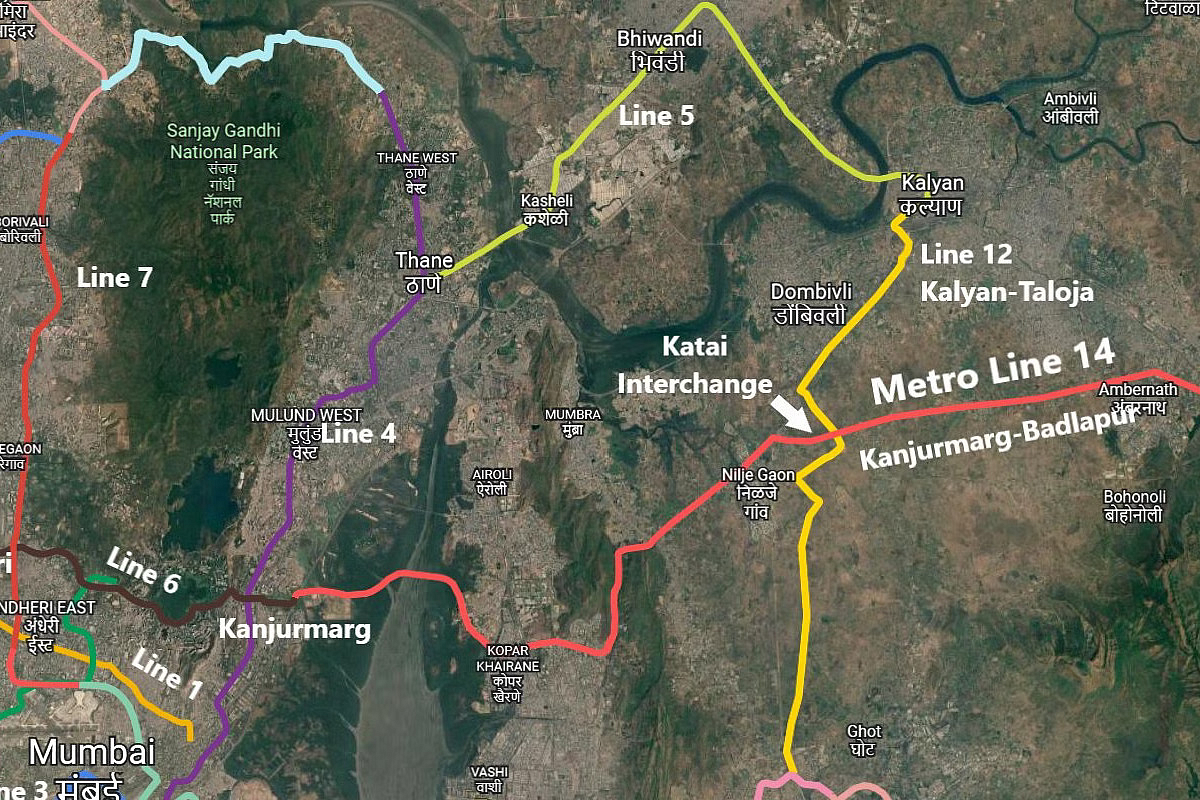Mumbai Metro Expanding Fast — Line 14 Will Link Kanjurmarg to Badlapur
By 2025, India has become one of the world’s metro leaders. More than 20 cities now have operational metro systems, with over 945 km of metro lines and 715+ stations running across the country. This puts India among the top three countries globally in terms of metro network size.
Metro rail has become a reliable and fast way to travel, especially in big cities. One such city is Mumbai, where the metro network is growing quickly. Several lines are already operational, while many others are under construction. One of the most anticipated new projects is Mumbai Metro Line 14, which will connect Kanjurmarg in central Mumbai to Badlapur in the outer suburbs.
Let’s take a closer look at this exciting new line.
Why Mumbai Needs Metro Line 14
Mumbai is one of the busiest cities in India. With its growing population and increasing number of vehicles, traffic has become a major problem. Traveling by road or even local trains can take 1.5 to 2 hours — especially from far-off areas like Badlapur, Ambernath, and Dombivli.

These areas have grown rapidly in the past 15 years, turning from small towns into important parts of the Mumbai Metropolitan Region (MMR). Most people living here depend on local trains or roads to reach the main city. The need to change trains at Thane adds to the crowd and increases travel time.
That’s where Metro Line 14 comes in. It will directly connect these outer suburbs with central Mumbai, reducing travel time drastically.
What is Metro Line 14?
Mumbai Metro Line 14 is a new proposed metro route that will run between Kanjurmarg and Badlapur. The total length of the line is expected to be around 38 kilometers. It will have 15 stations, including:
- 13 elevated stations
- 1 underground station
- 1 at-grade (ground-level) station
This line will be known as the Magenta Line and will pass through several important areas, including Ambernath, Nilje, Shilphata, Mahape, Ghansoli, and Thane Creek before reaching Kanjurmarg.
The project will be developed using the Public-Private Partnership (PPP) model.
How Will It Help Commuters?
Metro Line 14 will provide huge relief to people who live in Badlapur, Ambernath, Dombivli, and nearby areas. Currently, these people face long travel times and heavy traffic. The new metro line will:
- Save time: Travel that now takes 1.5–2 hours can be done in minutes
- Reduce road traffic: Fewer cars and buses will help ease congestion
- Lower pollution: Less vehicle use means cleaner air
- Provide comfort: Metro rides are more comfortable compared to crowded local trains and buses
According to studies by MMRDA (Mumbai Metropolitan Region Development Authority), the peak traffic in 2041 on this route could reach 54,000 passengers per day. The estimated number of daily users is:
- 5 lakh in 2026
- 6.5 lakh in 2031
- 7.5 lakh in 2041
Project Plans and Route Map
According to the Detailed Project Report (DPR), which is already approved by IIT Mumbai, Metro Line 14 will pass through important transport and development zones. The line will include three interchanges, helping passengers switch easily between metro lines:
- Kanjurmarg — Interchange with Metro Line 6 and suburban railway
- Vikhroli/Jogeshwari (planned) — Interchange with Metro Line 4
- Thane/Kasarvadavli (planned) — Interchange with Metro Line 5
This line will also pass through:
- Chikoli, a proposed transit-oriented development (TOD) zone
- Thane Creek, where 5.7 km of the route will pass through environmentally sensitive mangrove areas
- Parsik Hills, with about 4.38 km passing through hilly terrain
Environmental Clearance and Approvals
Since parts of the route go through protected natural areas like mangroves and hills, the MMRDA must get environmental clearance before construction begins. For this, an Environmental Impact Assessment (EIA) report will be prepared. MMRDA has already released a public notice on March 18, 2025, seeking expert advisors for this task.
Once the state government approves the project report, construction can begin—likely within the next year. MMRDA will then open tenders for contractors, invite bids, and begin construction planning.
Estimated Cost and Timeline
The total estimated cost of Metro Line 14 is ₹18,000 crore. This investment will include:
- Station construction
- Bridges and tunnels
- Land acquisition
- Train systems and signaling
Work is expected to start by early 2026, once all permissions are granted. If all goes smoothly, parts of the line could become operational by 2030.
Key Highlights of Mumbai Metro Line 14
| Feature | Details |
|---|---|
| Line Length | 38 km |
| Number of Stations | 15 (13 elevated, 1 underground, 1 at grade) |
| Route | Kanjurmarg to Badlapur |
| Areas Covered | Ambernath, Dombivli, Nilje, Mahape, Ghansoli, Shilphata |
| Project Model | Public-Private Partnership (PPP) |
| Estimated Cost | ₹18,000 crore |
| Interchanges | Metro Lines 4, 5, 6, and suburban railways |
| Construction Start | Expected in 2026 |
| Peak Ridership | 7.5 lakh/day by 2041 |
Conclusion
Mumbai Metro Line 14 is more than just a new metro project — it’s a game changer for people in outer Mumbai suburbs. With better connectivity, shorter travel times, and cleaner transportation, this line will improve the lives of lakhs of daily commuters.
As the metro network expands, Mumbai is moving one step closer to becoming a smart, efficient, and green city. With support from the government and speedy approvals, Metro Line 14 could become a model for future infrastructure projects across India.
| Select Mumbai Underground Local Train Project Train Route: New 5th And 6th Line Planned Between Csmt And Parel | Mumbai Underground Local Train Project Train Route: New 5th And 6th Line Planned Between Csmt And Parel |
|---|





